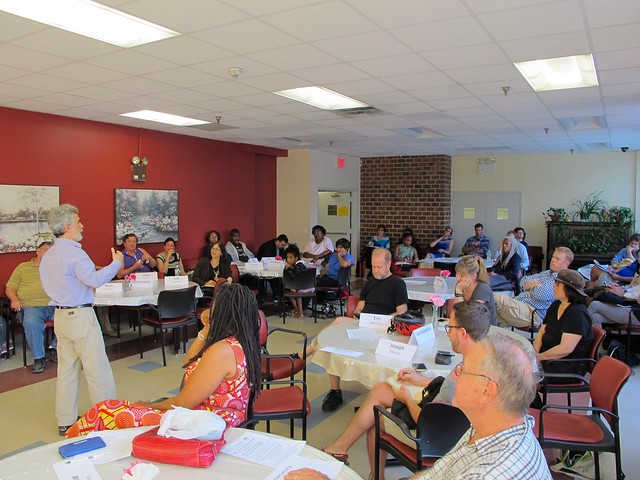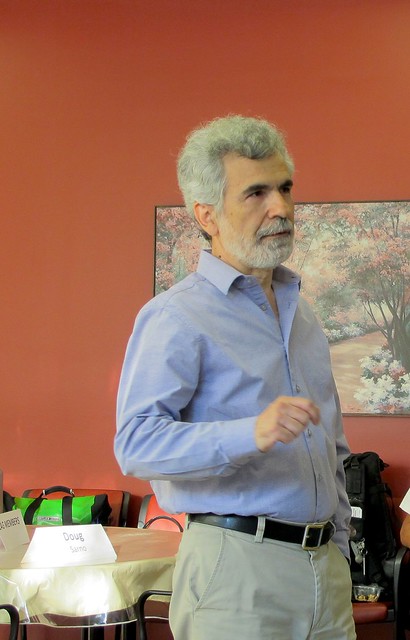Christos Tsiamis, EPA Remedial Project Manager for the Gowanus Canal Superfund
Doug Sarno, facilitator for Gowanus Canal Superfund Community Advisory Group
Christos Tsiamis, Environmental Protection Agency Remedial Project Manager for the Gowanus Canal Superfund clean-up, attended Tuesday night's meeting of the Gowanus Canal Community Advisory Group (CAG) to provide the public with a brief update. Most importantly, he wanted to clarify EPA's position on placement and size of the Combined Sewer Overflow retention tanks that his agency requires New York City to construct under the Record of Decision, which was signed back in September 2013.
"Some things have crossed my desk that I felt needed clarification", he told members of the CAG.
Tsiamis was referring to a public meeting held by New York City Department Of Environmental Protection (DEP) on May 14, 2015 on its Combined Sewer Overflow Long Term Control Plan for the Gowanus Canal, which the City is obligated to prepare under an order from New York State.
Though the Long Term Control plan has nothings to do with the EPA, DEP Commissioner Emily Lloyd at that meeting spoke at length about work that has to do with the EPA Superfund clean-up. In particular, the Commission discussed the potential location and the sizes of the two retention tanks mandated by the EPA as control measures to significantly reduce the combined sewer overflow (CSO) discharges to the Canal.
The EPA estimates that an 8-million gallon tank and a 4-million gallon tank will be required to address CSOs from the two largest outfalls, RH-034 and OH-007. Together, they will reduce the CSO in the canal by 58% to 74%.
At the May 14th meeting, DEP talked about reducing the sizes of the tanks from an 8 million gallon tank to a 3.5 or 5.7 million gallon tank at RH-034, and from a 4 million gallon tank at OH-007 to a 1.4 or 2.5 million gallon tank.
According to DEP calculations , the smaller sized tanks would be enough to achieve the 58% to 74% CSO reduction mandated by the EPA.
According to DEP calculations , the smaller sized tanks would be enough to achieve the 58% to 74% CSO reduction mandated by the EPA.
Commissioner Lloyd also indicated at the meeting that DEP is considering two sites for the retention tank for outfall RH-034. The first site is comprised of two privately owned lots directly adjacent to the canal between Douglass Street and DeGraw Street. The second location is Thomas Greene Park, which is on land already owned by the City. Lloyd told the public that her agency will be 'likely to recommend' to EPA the privately owned lots, primarily "because of its proximity to the rest of our infrastructure, it will be more efficient to construct and operate."
Even with the cost of acquiring the privately owned sites it would still be cost effective, Lloyd claimed. When asked what would happen if the owners of the private land were unwilling to sell, she explained that if "that is the selected site, we will proceed to eminent domain."
Obviously, some of what DEP presented to the public regarding sizes and preferred locations for the tanks is still very much under discussion with EPA.
At Tuesday's CAG meeting, Tsiamis wanted to make this very clear:
"I am here to say that the City can discuss that, but it so happened that a week before they presented that information to the public, I personally sent comments to New York City on exactly those two issues. On May 7th, I had commented on what the City presented to you on May 14th."
He continued:
"We took an exception to the suggested sizes of the tanks by New York City. The EPA made comments regarding the reduced sizes to the City. We do not agree and in our comments, we lay out the reasons why we do not agree, why we think the sizes need to be bigger than what New York City presented at that meeting. In other words, we told DEP that this is unacceptable and we are moving towards defining what is acceptable. And we expect a response.
I wanted to be clear that what the City presented to the public was not what will be constructed."
Regarding the DEP's preferred location of the tanks, Tsiamis had this to say:
"New York City has submitted to EPA an evaluation of two locations for each of the two CSO tanks.
We reviewed what New York City gave us and again, we had significant disagreements in the way the evaluations were conducted. Our disagreement was regarding the cost acquisition element and its weighting factor in the evaluation. In other words, it would cost the City much more to acquire land than the cost associated with siting the tank further from the canal.
We put this in writing, sent it to them and we are still waiting for their responses.
He added:They don't make the decision. We make the decision. The City is under a unilateral order: That is a one way street."
Despite the complexity of these projections, reports, and comments, it is clear that the EPA continues to steadfastly work towards our long awaited comprehensive cleanup while our local government drags its feet and undermines the process.
I guess it is too much to ask for DEP to step up its game and be more like the EPA.
On the other hand, as a community, we have the perfect right to demand just that.
And we should.
The correspondence from EPA to DEP was made available by Christos Tsiamis upon request
EPA COMMENTS ON NEW YORK CITY DEP’S “GOWANUS CANAL CSO TANK SITING” MEMO
"We took an exception to the suggested sizes of the tanks by New York City. The EPA made comments regarding the reduced sizes to the City. We do not agree and in our comments, we lay out the reasons why we do not agree, why we think the sizes need to be bigger than what New York City presented at that meeting. In other words, we told DEP that this is unacceptable and we are moving towards defining what is acceptable. And we expect a response.
I wanted to be clear that what the City presented to the public was not what will be constructed."
Regarding the DEP's preferred location of the tanks, Tsiamis had this to say:
"New York City has submitted to EPA an evaluation of two locations for each of the two CSO tanks.
We reviewed what New York City gave us and again, we had significant disagreements in the way the evaluations were conducted. Our disagreement was regarding the cost acquisition element and its weighting factor in the evaluation. In other words, it would cost the City much more to acquire land than the cost associated with siting the tank further from the canal.
We put this in writing, sent it to them and we are still waiting for their responses.
He added:They don't make the decision. We make the decision. The City is under a unilateral order: That is a one way street."
Despite the complexity of these projections, reports, and comments, it is clear that the EPA continues to steadfastly work towards our long awaited comprehensive cleanup while our local government drags its feet and undermines the process.
I guess it is too much to ask for DEP to step up its game and be more like the EPA.
On the other hand, as a community, we have the perfect right to demand just that.
And we should.
The correspondence from EPA to DEP was made available by Christos Tsiamis upon request
EPA COMMENTS ON NEW YORK CITY DEP’S “GOWANUS CANAL CSO TANK SITING” MEMO
(sent to Kevin Clarke, Project Engineer for NYC DEP on May 7, 2015)
General Comment:
There are several critical omissions and unrealistic assumptions that were utilized in assigning the weighing factors to the ranking elements listed in Attachment A, which ranks potential sites for the location of the retention tanks in the vicinity of tank location RH-34 as specified in EPA’s Record of Decision.
For example, the “Land Use and Environmental” criterion for “Known contamination/hazardous materials” has been given a weighting factor of 15. The description of the scaling factors does not include the assumption that the site will be remediated by others, namely National Grid, if excavation for the construction of a retention tank takes place and, therefore, would not be the responsibility of New York City (NYC). In addition, tank locations RH-3 and RH-4 have been given different ratings, although both of the sites are known to have significant contamination and RH-4 is also known to have large underground structures that will have to be removed. In addition, as mentioned above, these locations will not be remediated by NYC. Therefore, the ratings for this criterion should be at least the same and they should have a much higher rating than the one assigned because NYC would not be responsible for their remediation. This ranking criterion should be redefined and the scaling factor should be applied properly taking into account the above considerations.
Another criterion that is improperly assessed is the “Land Use and Environmental” criterion for “Property Acquisition.” This criterion is given a weighting factor of only 10%, which is much less than the 30% weighting factor assigned to the “proximity to existing infrastructure” criterion and two other criteria. NYC’s ability to build on property that it already owns, so that it does not have to acquire property that currently is at a premium in the Gowanus area, should have a much higher weighting factor than the one assigned. In our estimate, the weighing factor for this criterion should be at least 20%, if not 30%.
A weighting of 30% would be in line with the NYCDEP Commissioner’s statement at the 2014 Wyckoff Gardens public meeting that cost would be very important in considering the tank locations. It would also take into account the rapidly increasing costs for land acquisition in the area and the loss of tax revenue in perpetuity for at least two parcels that comprise tank location RH-3, the sum of which would be presumably much higher than the additional construction and operational costs that might be associated with tank location RH-4. NYC should also assume that any costs associated with the temporary relocation of the pool and services and their eventual restoration in tank location RH-4 would be at least shared with other parties.
For similar reasons, unless the costs associated with the “Proximity to Existing Infrastructure” criterion (i.e., the approximate costs of additional conveyance pipes) are comparable with the “Property Acquisition” costs, which is unlikely, as acquisition costs are in the tens of millions of dollars, the weighting factor assigned to the “Proximity to Existing Infrastructure” criterion should be reduced.
Please revise the rankings taking into account the above considerations.
EPA COMMENTS ON NYC’S “GOWANUS CANAL BASELINE CSO VOLUME MODELING AND CSO TANK SIZING”
General Comment:
While the overall baseline scenario is better defined in this document than in prior documents, there are no details for the projected future dry weather sewage flows. It is simply stated in the document that these new projections were “updated from 2045 projection to 2040 projection and include water conservation.” What other assumptions were made for projected dry weather flows? Do the flows account for ongoing and future redevelopment activities in the sewer drainage area that will increase dry weather flows in the future? Also, a detailed description of the flow projections for the Red Hook and Owls Head WWTP service areas that were used were not provided. Because EPA intends to review the underlying data and assumptions utilized throughout the tank design process, adequate supporting information should be included in future reports.
The tank size calculations indicate that smaller tank sizes may be sufficient to achieve the reduction goals. The report, however, does not describe how the tanks were modeled or where they were modeled in the combined sewer systems. In addition, the report does not describe the potential uncertainty in the model calculations themselves and the uncertainty of the eventual location of the tanks, the capacity of the infrastructure to convey flows to the tanks and their final design volume for a given site. A description of these factors is necessary for this analysis and should be included in the eventual recommendations for tank sizes.
The report states that the tide/boundary condition downstream of the RH-034 outfall was corrected. What provisions has New York City made in its combined sewer hydraulic and discharge calculations and plans for sea level rise and changes in rainfall that are described in older and more recent New York City Reports on Climate Change?
Given that there are several uncertainties associated with future conditions, as described above, a conservative approach would have to be taken in designing the retention tanks called for in EPA’s Record of Decision. Accordingly, consistent with such an approach, the tank sizes cited in Table 2 of the document under the “2014 LTCP Model 74% [solids reduction]” should be used to design the tanks rather than the volumes recommended in the report’s “Summary and Conclusions” section. This percent reduction represents reductions estimated on the basis of the upper confidence limit of the data for PAHs. Finally, owing to the uncertainties associated with potentially significant future development in the area and with climate change, an engineering error factor should be applied to calculate the final recommended volumes of the retention tanks. Appropriate adjustments can be made to these preliminary assumptions as the remedial design progresses and further data and analysis are developed.
General Comment:
There are several critical omissions and unrealistic assumptions that were utilized in assigning the weighing factors to the ranking elements listed in Attachment A, which ranks potential sites for the location of the retention tanks in the vicinity of tank location RH-34 as specified in EPA’s Record of Decision.
For example, the “Land Use and Environmental” criterion for “Known contamination/hazardous materials” has been given a weighting factor of 15. The description of the scaling factors does not include the assumption that the site will be remediated by others, namely National Grid, if excavation for the construction of a retention tank takes place and, therefore, would not be the responsibility of New York City (NYC). In addition, tank locations RH-3 and RH-4 have been given different ratings, although both of the sites are known to have significant contamination and RH-4 is also known to have large underground structures that will have to be removed. In addition, as mentioned above, these locations will not be remediated by NYC. Therefore, the ratings for this criterion should be at least the same and they should have a much higher rating than the one assigned because NYC would not be responsible for their remediation. This ranking criterion should be redefined and the scaling factor should be applied properly taking into account the above considerations.
Another criterion that is improperly assessed is the “Land Use and Environmental” criterion for “Property Acquisition.” This criterion is given a weighting factor of only 10%, which is much less than the 30% weighting factor assigned to the “proximity to existing infrastructure” criterion and two other criteria. NYC’s ability to build on property that it already owns, so that it does not have to acquire property that currently is at a premium in the Gowanus area, should have a much higher weighting factor than the one assigned. In our estimate, the weighing factor for this criterion should be at least 20%, if not 30%.
A weighting of 30% would be in line with the NYCDEP Commissioner’s statement at the 2014 Wyckoff Gardens public meeting that cost would be very important in considering the tank locations. It would also take into account the rapidly increasing costs for land acquisition in the area and the loss of tax revenue in perpetuity for at least two parcels that comprise tank location RH-3, the sum of which would be presumably much higher than the additional construction and operational costs that might be associated with tank location RH-4. NYC should also assume that any costs associated with the temporary relocation of the pool and services and their eventual restoration in tank location RH-4 would be at least shared with other parties.
For similar reasons, unless the costs associated with the “Proximity to Existing Infrastructure” criterion (i.e., the approximate costs of additional conveyance pipes) are comparable with the “Property Acquisition” costs, which is unlikely, as acquisition costs are in the tens of millions of dollars, the weighting factor assigned to the “Proximity to Existing Infrastructure” criterion should be reduced.
Please revise the rankings taking into account the above considerations.
EPA COMMENTS ON NYC’S “GOWANUS CANAL BASELINE CSO VOLUME MODELING AND CSO TANK SIZING”
(sent to Kevin Clarke, Project Engineer for NYC DEP on May 7, 2015)
General Comment:











.JPG)

4 comments:
I have been trying to figure out what The City's motivation is in wasting time and money exploring non-viable alternatives to the ROD. It is really irresponsible and a disservice to the community for DEP to be presenting inaccurate information to the public. Is it a PR maneuver because the possible closure of Thomas Green park will be an inconvenience? Is it political posturing?
Statement taken directly from DEP public presentation:
EPA ROD requires an estimated reduction of 58% to 74% of sewer solids at:
• OH-007 • RH-034
DEP CERCLA remedy will be the proposed LTCP.
DEP has clearly stated that their EPA remedy work IS their Long Term Control Plan. They have completely folded the two into one just as they have always wanted to do.
The DEP stated their EPA ROD requirements solely in terms of percentage-of-reduction. The DEP presentation also stated that the tanks were "under evaluation", that is not being planned, but just evuluated. And the presentation clearly states they are looking to "alternatives to tanks".
AND the DEP closes their presentation saying that their NEXT STEP is :
DEP will continue analysis of alternatives.
Doesn't sound like the DEP is seriously moving forward with any actual tank planning.
their presentation:
http://www.nyc.gov/html/dep/pdf/cso_long_term_control_plan/gowanus_canal_meeting_2_presentation.pdf
Please contact the DEP to ask that they stop wasting rate-payer funds with their endless "analysis of alternatives".
Question to seriously think about. Is it irresponsible for local government or any gov't agency for that matter to try to find solutions that will save tax payers hundreds of millions of dollars while at the same time attempting to save a precious local asset like DD? It's just seems all too easy for EPA to demand this and that when they have absolutely no skin or dollars in the game.
11:23 The DD pool is not a "precious local asset" in its current state - but paved over highly toxic land, including a migrating volatile plume. That plume is migrating to resindential areas- including the building I live in. And to suggest that the City is trying to save taxpayers hundreds of millions of dollars is untrue. The EPA's solution is a two for one. The park is public land - the land it is on needs to be remediated.
The City wants to use eminent domain(if necessary) to acquire its site, and it does not address the toxic plume. It's a no brainer.
Post a Comment